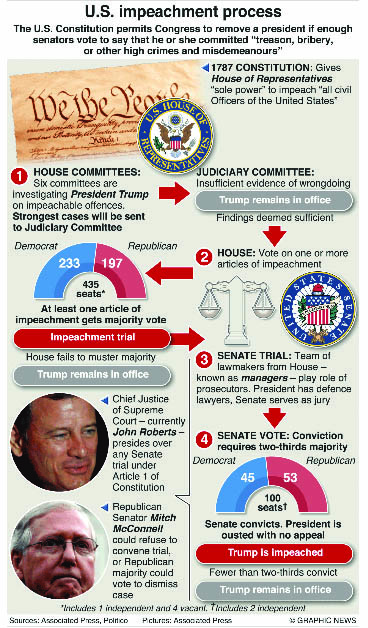
OR
U.S. impeachment process
Published On: November 3, 2019 12:00 AM NPT By: Republica | @RepublicaNepal

The U.S. Constitution permits Congress to remove a president before his or her term is up if enough senators vote to say that they committed “treason, bribery, or other high crimes and misdemeanours.” Article Two, Section 4 of the Constitution gives the House of Representatives the sole power to impeach a federal official, including the president. On October 31 the House voted to approve and proceed with its impeachment inquiry. The resolution, passed on a mostly party-line 232-196 vote, sends a clear signal that a vote to impeach President Donald Trump, and a trial in the Senate, is all but inevitable.
A two-thirds majority in the Senate is required to convict and remove a president from office -- which has never successfully happened. While the Constitution sets out that if the House impeaches an official, the next step is for the Senate to hold a trial, there is no precise enforcement mechanism.
Article One of the Constitution stipulates that the Chief Justice of Supreme Court -- currently John Roberts -- should preside over any Senate trial.
Trump becomes just the fourth president to be subject to a formal impeachment effort.
You May Like This

Harry Bhandari of Nepali origin wins the Senate in US' mid-term election
UNITED STATES, Nov 7: Harry Bhandari of Nepali origin has the won the Senate in the mid-term election of the... Read More...

War hero and presidential candidate John McCain dies at 81
WASHINGTON, Aug 26: Sen. John McCain, who faced down his captors in a Vietnam prisoner of war camp with jut-jawed... Read More...

Congress committed to implement constitution: Minister Lekhak
ITAHARI, Sept 11: Minister for Physical Infrastructure and Transport Ramesh Lekhak has said that the Nepali Congress was working hard... Read More...




Just In
- CM Kandel requests Finance Minister Pun to put Karnali province in priority in upcoming budget
- Australia reduces TR visa age limit and duration as it implements stricter regulations for foreign students
- Govt aims to surpass Rs 10 trillion GDP mark in next five years
- Govt appoints 77 Liaison Officers for mountain climbing management for spring season
- EC decides to permit public vehicles to operate freely on day of by-election
- Fugitive arrested after 26 years
- Indian Potash Ltd secures contract to bring 30,000 tons of urea within 107 days
- CAN adds four players to squad for T20 series against West Indies 'A'














Leave A Comment